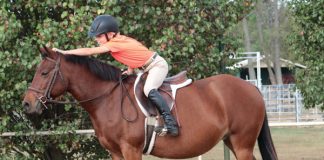The shoulder-in is one of the best exercises for suppling a horse, building his strength, and increasing his freedom in the shoulder. But the precursor to the shoulder-in is the shoulder-fore, which is also an excellent movement to help with everyday training issues, in particularly the canter.
The shoulder-fore requires a lesser degree of angle and bend than the shoulder-in. The aids are the same, but are used with less intensity. Your horse should learn the shoulder-fore first: Once he understands it, the angle can be increased for the shoulder-in. Most riders can’t feel the shoulder-fore, so it is helpful to have an experienced friend or trainer watching from the ground.

Because of this wedge-shape, horses tend to carry their haunches off the track as they canter. To straighten the canter, try this shoulder-fore exercise:
Develop the shoulder-fore at the trot on a 20-meter circle, asking for only a few steps at a time. If all is going well, you’ll begin to notice your horse moving better and becoming more flexible. Now pick up a canter on the same 20-meter circle, and ask for a few steps of shoulder-fore. Remember the angle is very slight. You want your horse’s shoulders in line with his haunches — in other words, a straight canter. Now ride straight ahead around the arena, holding the shoulder-fore as you go. If you feel your horse becoming crooked again, bring him back on the 20-meter circle and re-establish the shoulder-fore. If your horse doesn’t understand at first, be patient. You’re asking him to put more weight on his inside hind leg, and he might resist at first. When you get a few good steps, end the exercise.
Horses also tend to swing their haunches in during the upward and downward canter transitions. Be ready for this by asking for a step or two of shoulder-fore before the transition.
Besides creating balance, another benefit of the shoulder-fore in the canter is increased strength and weight-bearing on the haunches. It’s interesting to note that many riders feel that the canter should always be ridden in a shoulder-fore, due the horse’s wedge-shape.







You don’t explain how to obtain the shoulder fore in your article. You just say do it – an explanation of how to obtain it – leg position etc would be helpful.
I agree w/the comment on how to ask for this shoulder-fore properly.
Exactly what I was thinking too! How do we ask for the shoulder fore and shoulder in?
Thanks
I just now watched this video on shoulder fore and have the same question – how do you do it – that has not been answered since 2008???